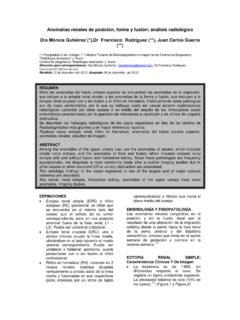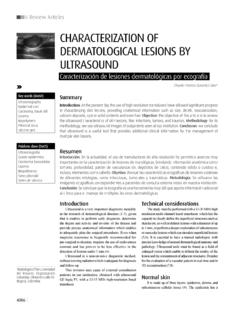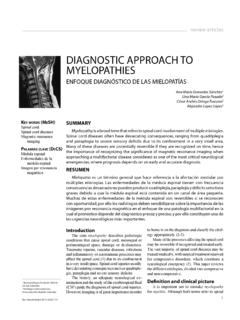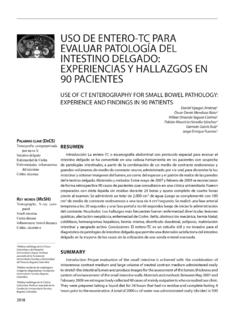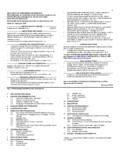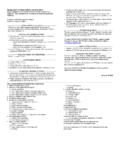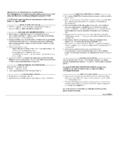Transcription of Intravenous iodinated contrast media and metformin ...
1 contrast mediaCommentaryIntravenous iodinated contrast media and metformin : interactions and precautionsMiriam Zalazar (1),Noelia Tobia (1),Estela Guerra (1),Dora Isolabella (1,2) According to the last National Survey of RiskFactors conducted in Argentina (2009), the prevalenceof diabetes is (1)About 90% of diabetic subjectshave diabetes type 2 and this figure grows every yearas a result of a poor diet, overweight, obesity and anincreased life most of these patients die from atherosclerosisor ischemic heart disease or suffer from kidney disea-se, they are expected to require a large number ofdiagnostic tests with Intravenous (IV) iodinated con-trast media (angiography, urography, chole-cysto-graphy, computed tomography, etc.)
2 metformin is a first-line oral antidiabetic drug,therefore it is commonly used by patients with type 2diabetes undergoing contrast -enhanced medical literature reports several cases of lac-tic acidosis, a serious adverse effect in patients treatedwith metformin who undergo studies involving IViodinated contrast paper focuses on the interactions and precau-tions in diabetic patients receiving metformin who mustundergo a study with IV iodinated contrast with diabetes and renal functionDiabetes is the most common cause of chronicrenal failure and the main cause of end-stage renaldisease. Forty percent of adults with diabetes of adults with prediabetes have some renalfunction impairment (2).
3 Based on these statistics, diabetic patients com-monly have some degree of renal failure. As creatini-ne clearance (considered as the gold standard forassessing renal function) is not available for allpatients before the study, it may be predicted fromserum creatinine, theoretical weight and age of thepatient using the Cockroft-Gault formula:CrCl (males) in ml / min = (140 - age) x IBW / (72 x Scr)CrCl (females) in ml / min = (140 age) x IBW x / (72 x Scr)[Scr = serum creatinine (mg / dL), CrCl = creatinine clearan-ce, IBW = ideal body weight]The Sociedad Espa ola de Nefrolog a (SpanishSociety of Nephrology) has a useful online calculatorthat provides an immediate calculation from the dataentered (age, gender, serum creatinine, weight andheight) (3).
4 Pharmacological features of metforminMetformin is the main oral antidiabetic drug thatlowers blood glucose levels without causing hypogly-cemia or weight gain. This drug has multiple and extrapancreatic actions: It inhibits glucose formation It decreases intestinal glucose absorption It promotes the uptake of glucose in muscle, adipo-se tissue, and other tissues, as it increases the expres-sion of glucose transporter is absorbed at intestinal level by approxi-mately 60%, it is negligibly bound to plasma proteinsand is eliminated unchanged by glomerular filtrationand tubular secretion (no metabolites or enterohepaticcirculation have been identified). Following adminis-tration, 90% of the absorbed drug is eliminated withinthe first 24 hours.
5 It has a half-life of approximately (ranging from 4 to h) (4).Lactic acidosis is the most dangerous adverse effect ofmetformin (this is the reason why another drug of thesame class has been withdrawn from the market). Thiscondition is associated with a mortality rate of 40%and risk factors that contraindicate the administrationof metformin have been identified to prevent its occu-rrence, namely: Chronic hypoxemic conditions Respiratory failure Hepatic failure Heart failure Renal failure Sepsis or severe infectionThese factors depress the ability to metabolize lactate(as it is the case of hepatic failure or alcohol abuse) orincrease lactate production (in the case of heart failu-re, respiratory failure, peripheral muscle ischemia orsevere infection).
6 The initial symptoms of lactic acidosis are insidious:(1)Docentes de la Primera C tedra de Farmacolog a, Licenciatura enProducci n de Bioim genes, Universidad de Buenos Aires. (2) Profesora Adjunta de la Segunda C tedra de Farmacolog a,Facultad de Medicina, Universidad de Buenos : Prof. Dra. Dora Isolabella abril 2011; aceptado: agosto 2011 Received: april 2011; accepted: august 2011 SAR-FAARDITRAR - Volumen 75 - N mero 4 - 2011P gina 1 Intravenous iodinated contrast media and metformingeneral poor health, hyper-ventilation, hypotension,vomiting, abdominal pain and stupor. The diagnosisis confirmed by increased blood lactate concentrationand mechanism of lactic acidosis induction by metfor-min is complex and it is associated to the shift of glu-cose metabolism from aerobic to anaerobic, resultingin an increased production of lactate by the acidosis results from an increase in blood levelsof metformin due to a decrease in its clearance becau-se of renal failure (5).
7 Even if metformin does not cause renal failure as anadverse effect, it is counter indicated in patients withrenal impairment because of the possibility of leadingto fatal lactic characteristics of iodinatedcontrast mediaIodinated contrast media , when administered intrave-nously, have a distribution volume of l/kg of body weight, a value consistent with dis-tribution in the extracellular space. These media havevery low binding to proteins (<10%) and their half-lifeis short (2-3 hours). They do not undergo hepaticmetabolism and are excreted unchanged via the renalroute, almost entirely by glomerular filtration. In patients with normal renal function, over 90% ofcontrast media is eliminated within the first 24 some patients, especially in the elderly and chil-dren, glomerular filtration may be decreased by up to50%, even with normal serum creatinine levels (forexample, due to reduced muscle mass).
8 This couldresult in an increase in the half-life of iodinated con-trast media and metformin , which would stay in thebody for a more prolonged time. Coadministration of iodinated contrast mediaand metforminThere are several published cases of death from lacticacidosis in patients who were taking metformin andunderwent studies involving the administration of IViodinated contrast media (6, 7, 8, 9).Evidence of lactic acidosis in patients receiving met-formin undergoing studies with iodinated contrastmedia is based on a isolated case reports that havebeen heterogeneously iodinated contrast media are not an independentrisk factor from lactic acidosis in patients taking met-formin, but they are a concern in the presence ofunderlying renal disorders.
9 Although contrast media -induced renal failure is very rare in patients with nor-mal renal function, elderly patients with reducedmuscle mass may exhibit a normal serum creatininelevel in the presence of a markedly depressed glome-rular filtration rate. The Food and Drug Administration (FDA) establishedthat prescription information should state that metfor-min should be temporarily withheld for patientsundergoing studies using IV iodinated contrastmedia, as they may cause acute renal failure and pro-mote the accumulation of metformin and lactic acido-sis (2, 10, 11, 12).Almost all the Diagnostic Imaging Societies have gui-delines for the use of IV iodinated contrast media inpatients receiving metformin .
10 With slight variations,these guidelines in general recommend that metfor-P gina 2 RAR- Volumen 75 - N mero 4 - 2011 Category IWith normal renal function and no is no need to discontinue metformin , nor is therea need to check serum creatinine IIWith normal renal function, but with comorbidities metformin should be discontinued at the time of for lactic acidosis, such as:the study and withheld for 48 Decreased metabolism of lactate- Increased anaerobic metabolism- Liver dysfunction- Alcohol abuseReinstitution of metformin will depend on the - Cardiac or respiratory failure, sepsis, severe infection, etc. patient s clinical - Concomitant administration of nephrotoxic medicationsCommunication between the radiologists and the (including, but not limited to, aminoglycosides).
